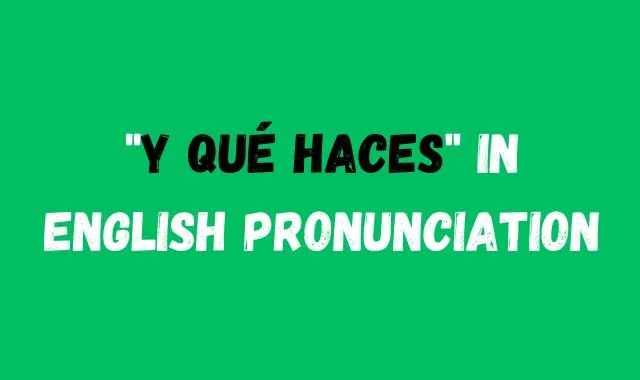If you’re learning Spanish and come across the phrase “Y qué haces,” you might be curious about how to pronounce it in English. This common Spanish expression can have multiple meanings, depending on context. Here’s a breakdown of its pronunciation and meaning.

What Does “Y Qué Haces” Mean in English?
In English, “Y qué haces” translates to “And what are you doing?” It’s often used in casual conversations when asking about someone’s current activity. Let’s dive into how to pronounce it correctly.
The phrase “Y qué haces” is widely used in Spanish-speaking countries and is a conversational way to ask someone what they are doing.
How to Pronounce “Y Qué Haces” in English Phonetics
Breaking down the phrase can make pronunciation easier:
- Y (ee) – Pronounce it as a long “ee” sound.
- Qué (keh) – Similar to “kay,” but with a softer “eh” sound at the end.
- Haces (AH-sehs) – The “H” is silent. Focus on the “AH” and end with a soft “sehs.”
When said together, the phrase sounds like “ee keh AH-sehs.” Practicing the pronunciation will make it flow naturally.
When to Use “Y Qué Haces” in Conversation
You would use “Y qué haces” in the same way you’d say, “What are you doing?” in English. It’s a polite and friendly way to engage with someone, whether you’re asking out of curiosity or just starting a casual chat.
In Spanish, the letter “H” is silent in most cases. So when pronouncing “haces,” the “H” is not pronounced, making it sound like “AH-sehs.”
Examples of “Y Qué Haces” in a Sentence:
- Friend 1: “Hola, ¿cómo estás?” Friend 2: “Estoy bien. ¿Y qué haces?”Translation: Friend 1: “Hi, how are you?” Friend 2: “I’m good. And what are you doing?”
- Parent: “No te he visto en todo el día. ¿Y qué haces?”Translation: Parent: “I haven’t seen you all day. What are you doing?”
These examples highlight the versatility of the phrase in everyday conversations.
The word “qué” in Spanish is pronounced “keh,” not “kay” as it might be in English phonetics. This is a common point of confusion for English speakers learning Spanish.
Common Mistakes to Avoid in Pronunciation
- Mispronouncing the “Qué” – Many English speakers say “kay,” but remember that in Spanish, it’s pronounced with a softer “keh.”
- Pronouncing the “H” in Haces – The “H” is silent. Avoid adding an English “h” sound at the beginning.
The English translation of “Y qué haces” is “And what are you doing?” It’s commonly used to inquire about someone’s current activity in an informal setting.
Conclusion
Mastering the pronunciation of “Y qué haces” is not only a great addition to your Spanish vocabulary but also a gateway to more engaging conversations. By breaking down the phrase into its components, you can practice and gain confidence in your speaking skills.
Using “Y qué haces” allows you to connect with others and show genuine interest in their lives. This phrase is perfect for casual settings, making it an essential tool for anyone looking to navigate everyday interactions in Spanish. Whether you’re chatting with friends, family, or even new acquaintances, this expression can help foster relationships and create a warm atmosphere.
Furthermore, understanding the nuances of this phrase can enhance your overall language learning experience. It encourages you to think about context, tone, and the subtleties of conversation. As you incorporate “Y qué haces” into your dialogues, you’ll not only improve your pronunciation but also develop a deeper appreciation for the Spanish language and culture.
The word “qué” directly translates to “what” in English, which is a key component of many question phrases in Spanish.
FAQs
1. What does “Y qué haces” mean in English?
In English, “Y qué haces” means “And what are you doing?” It is often used in casual conversations to ask someone about their current activity.
2. How do you pronounce “Y qué haces”?
The phrase is pronounced as “ee keh AH-sehs.” The “H” in haces is silent, and the “qué” is pronounced like “keh” with a soft “eh” sound.
3. When should I use “Y qué haces”?
You can use “Y qué haces” in conversations when you want to ask someone what they are doing. It’s a common phrase used in friendly, informal chats.
4. Is “qué haces” formal or informal?
“Qué haces” is an informal phrase, typically used in casual conversations. If you want to ask someone more formally, you could say, “¿Qué está haciendo?” (What are you doing?).
5. What are common mistakes in pronouncing “Y qué haces”?
The most common mistakes are:
- Mispronouncing “qué” as “kay” instead of “keh.”
- Pronouncing the “H” in haces, which should be silent.
6. Can “Y qué haces” have different meanings?
Yes, depending on context, “Y qué haces” could also imply curiosity or surprise about what someone is doing, but the general meaning is “And what are you doing?”
7. Is “Y qué haces” used in all Spanish-speaking countries?
Yes, the phrase is commonly used across all Spanish-speaking countries, though accents and regional variations in pronunciation may exist.
8. How can I practice saying “Y qué haces” correctly?
You can practice by breaking down the phrase and repeating each part slowly: “ee” for Y, “keh” for qué, and “AH-sehs” for haces. Repetition will help improve your pronunciation.


More Stories
ISB Brings You Verified Sports Breaking News
Gutter Cleaning Service by Gutterdogs
Prevent Costly Damage with Expert Timber Repairs